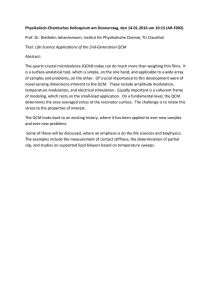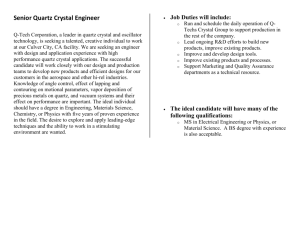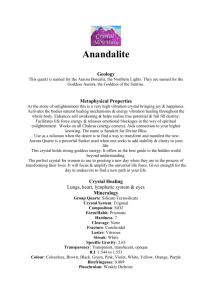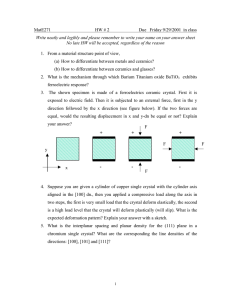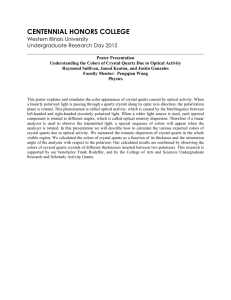Dynamic Response of Quartz Crystal Microbalances in Please share
advertisement
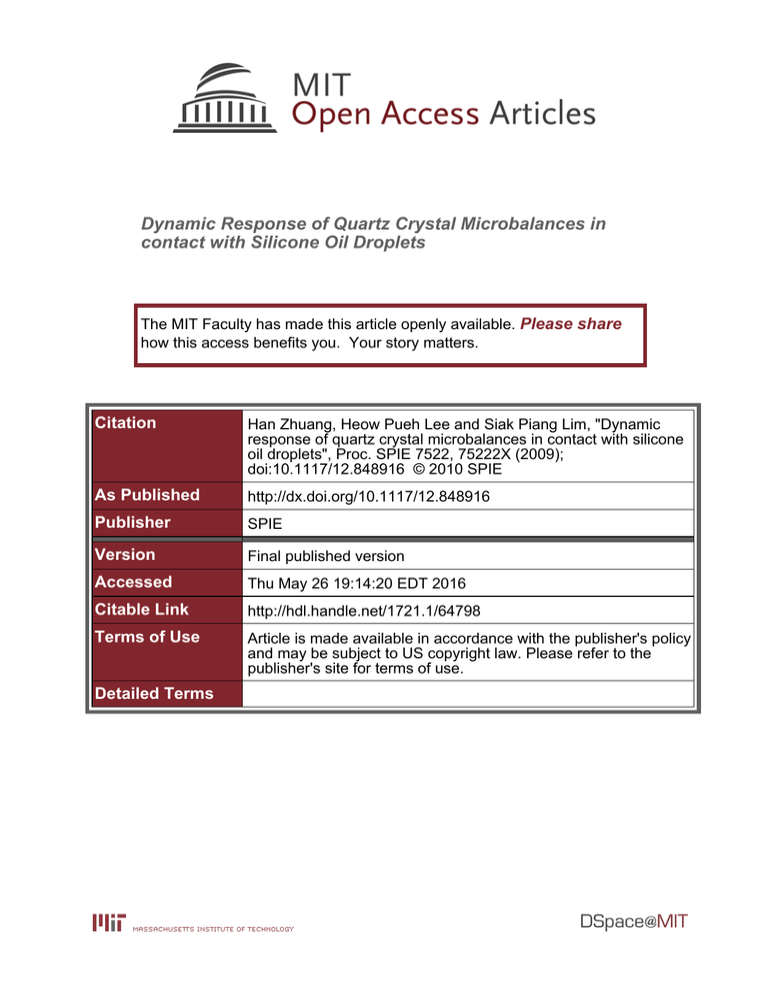
Dynamic Response of Quartz Crystal Microbalances in contact with Silicone Oil Droplets The MIT Faculty has made this article openly available. Please share how this access benefits you. Your story matters. Citation Han Zhuang, Heow Pueh Lee and Siak Piang Lim, "Dynamic response of quartz crystal microbalances in contact with silicone oil droplets", Proc. SPIE 7522, 75222X (2009); doi:10.1117/12.848916 © 2010 SPIE As Published http://dx.doi.org/10.1117/12.848916 Publisher SPIE Version Final published version Accessed Thu May 26 19:14:20 EDT 2016 Citable Link http://hdl.handle.net/1721.1/64798 Terms of Use Article is made available in accordance with the publisher's policy and may be subject to US copyright law. Please refer to the publisher's site for terms of use. Detailed Terms Dynamic Response of Quartz Crystal Microbalances in contact with Silicone Oil Droplets Han Zhuang ∗ 1, Heow Pueh Lee 2, Siak Piang Lim 2 1 Singapore-MIT Alliance, E1-02-01, 1 Engineering Drive 2, Singapore 117576 2 Department of Mechanical Engineering, National University of Singapore, 9 Engineering Drive 1, Singapore 117576 Abstract Quartz crystal microbalances (QCMs) in contact with liquid droplets have been used to investigate the rheological properties of liquids and the diverse solid-liquid interfacial phenomena. In this article, we first report the experimental results of the QCM responses due to the deposition of microliter droplets of silicone oils. The silicone oils with viscosity in a range from 50cS to 103cS are tested. It has been found that the responses in the frequency and resistance measurements of the QCM in contact with the silicone oils are different from the Newtonian liquids. More importantly, it has been found that for the silicone oils the frequency of the QCM steadily increases for several hours and even exceeds the initial value of the unloaded QCM which has resulted in the positive frequency changes. The collaborative effects of the interfacial slip and viscoelasticity have been discussed to qualitatively interpret the positive frequency changes. Secondly, we discuss the cyclical variations in the frequency and resistance during the experiments of the silicone oils, which are attributed to the generation of the compressional wave in the droplets. The present work has shown some phenomena which need to be taken into consideration when using the droplet QCM as a rheological sensor and may stimulate the ongoing research on the related issues in the QCM community. Key words: Quartz Crystal Microbalance, viscoelasticity, interfacial slippage, compressional wave 1. Introduction The quartz crystal microbalance (QCM) is typically consisted of a thin disk of an AT-cut quartz crystal with circular metal electrodes on both surfaces. The QCM has been widely used to monitor the thickness change of film deposition according to the Sauerbrey equation [1] which relates the decrease in frequency Δf of the QCM and the added mass Δm of the thin film rigidly coupled to the crystal surface: Δf = − 2 f 02 A ρ q μq Δm (1) where f 0 is the crystal fundamental frequency, A is the piezoelectric active area, ρ q and μq are the density (2650 kgm-3) and the shear modulus (2.94×1010 Nm-2) of the AT-cut quartz, respectively. When operating in liquid, the non-rigid mass will not oscillate in phase with the underlying crystal. An evanescent thickness-shear-mode (TSM) wave is generated near the interface region which is characterized by a decay length as: δ= * ηL π f0 ρL Corresponding author. Email: smazh@nus.edu.sg Fourth International Conference on Experimental Mechanics, edited by C. Quan, K. Qian, A. Asundi, F. S. Chau, Proc. of SPIE Vol. 7522, 75222X · © 2010 SPIE · CCC code: 0277-786X/10/$18 · doi: 10.1117/12.848916 Proc. of SPIE Vol. 7522 75222X-1 Downloaded from SPIE Digital Library on 29 Jul 2010 to 18.51.1.125. Terms of Use: http://spiedl.org/terms (2) where ρ L and η L are the liquid viscosity and density, respectively. The decay length for water ( ρ L = 103 kgm-3 and η L = 10-3 Nm-2) contacting a 5 MHz quartz crystal is about 250 nm. The change in frequency of the QCM with one surface fully covered by a Newtonian fluid is characterized by the Kanazawa equation [2]: Δf = − f 03 / 2 ρ Lη L πρ q μq (3) The Kanazawa equation is valid for a crystal of infinite lateral size which assumes a uniform shear velocity distribution across the crystal surface. However, a real crystal of finite lateral size results in a non-uniform distribution and hence a radial dependent of mass sensitivity that is greatest at the center and decreases toward the perimeter in an approximately Gaussian fashion [3, 4]. In terms of mass conservation, the compressional wave normal to the contact surface will generate in fluid due to the variation of the in-plane flow [3]. While the shear wave decays rapidly in a short distance at the fluid-crystal interface, the compressional wave can propagate a considerable distance in fluid and reflect back to the fluid-crystal interface to affect the crystal’s response. Generation of the compressional wave has been confirmed by the interference experiments consisting of a fluid cavity confined between a QCM and a flat glass reflector [3, 5-7]. If the spacing of the fluid cavity reaches a multiple of λc /2 ( λc is the compressional wave length), the constructive interferences of the acoustic wave will happen and the discontinuities in the frequency measurements of the QCM can be observed. The free surface of the fluid layer can also act as a reflecting surface of the compressional waves and perturb the crystal’s oscillating response. In biomedical and pharmaceutical industries, the fluid samples for rheological analysis are often expensive or available in small volume. It has stimulated the development of the droplet QCM loaded with a small droplet to perform certain analysis. Several studies reported the applications of the droplet QCM for assessing the viscosity of liquids [8-10]. It has also been used to investigate the dynamic wetting phenomena of liquids and the evaporation of droplets of volatile liquids [11-14]. In these studies, the generation of compressional wave was observed in the frequency measurements albeit few being discussed in detail. McKenna et al. [15] have studied the response of the QCM in contact with small water droplet by using simultaneous frequency measurements and video microscopy. The experimental results suggest that the compressional wave generation would happen when the droplet height reaches integer multiples of a half of the acoustic wavelength. Couturier et al. [16] have also reported the correlation between the size of the water droplet and the compressional wave generation in both the experimental measurements and the finite element simulations. In this article, we first report the experimental results of the QCM responses due to the deposition of microliter droplets of silicone oils. The silicone oils with viscosity in a range from 50cS to 103cS are tested. It has been found that the responses in the frequency and resistance measurements of the QCM in contact with the silicone oils are different from the Newtonian liquids. More importantly, it has been found that for the silicone oils the frequency of the QCM steadily increases for several hours and even exceeds the initial value of the unloaded QCM which has resulted in the positive frequency shift. Collaborative effects of interfacial slip and viscoelasticity have recently been discussed to qualitatively interpret the positive frequency shift. Secondly, we discuss the cyclical variations in the frequency and resistance measurements of the QCM during the silicone oil experiments, which are attributed to the generation of the compressional wave in the droplets. In the scenario of spreading hydrodynamics, the eigenmodes of the compressional wave in the droplets are also calculated by the finite element computation and compared with the experimental results. 2. Experiment The experimental setup is shown in Figure 1. The 5 MHz AT-cut quartz crystals (diameter of 25.4 mm and thickness of 0.33 mm) were used. Polished gold electrodes (~ 160 nm) were deposited on chromium adhesion layers (~ 15 nm) on both sides. An asymmetric pattern was adopted, where the upper electrode in contact with the fluid media had a larger radius ( reupper =6.45 mm) than the lower one ( relower =3.3 mm). The crystal sensor was driven by a Research Quartz Crystal Microbalance (RQCM) (Maxtek Inc.). A PC was linked to the RQCM to record the changes in the resonant frequency and dissipation of the crystal. The crystal holder was enclosed in a chamber, where the temperature and relative humidity were controlled as 23 ± 0.5o C and 60 ± 5% . Proc. of SPIE Vol. 7522 75222X-2 Downloaded from SPIE Digital Library on 29 Jul 2010 to 18.51.1.125. Terms of Use: http://spiedl.org/terms Figure 1 Schematic diagram of the experimental setup. Droplets of KF96 silicone oils (Shin-Estu Chemical) with the viscosity ranging from 50 cS to 103 cS were deposited to the top electrode of the crystal by a digital pipet. The volume was 2 µL. Microscopy with crosshair reticule was focused to center the droplet. The measurements for silicone oils would be for at least 6 h for the crystal’s responses to be stabilized and exhibit the long term trend. Crystals after use were washed thoroughly in xylene (Fisher Scientific) and dried in air until the initial values of the frequency and resistance under the unloaded condition were obtained. 3. Results and Discussion 2000 100 1800 −100 −200 −300 −400 1800 1400 Resistance Change (Ohm) Resistance Change (Ohm) A1 Frequency Shift (Hz) A1 1600 0 1200 1000 800 600 400 1750 1700 1650 1600 1550 1500 1450 0 −600 5 200 −500 0 5 10 15 20 25 0 5 10 10 30 15 20 Time (min) 15 Time (min) 25 20 30 25 30 Time (min) (A) 50 cS (a) 50 cS 3000 1400 2700 B1 1200 2400 800 600 400 200 B1 2100 2500 1800 1500 1200 900 600 0 2400 2300 2200 2100 2000 300 −200 0 −400 Resistance Change (Ohm) Resistance Change (Ohm) Frequency Shift (Hz) 1000 0 5 10 15 20 25 30 35 Time (min) 40 45 50 55 0 5 60 (B) 100 cS 10 15 5 20 10 15 20 25 30 35 40 45 50 55 60 Time (min) 25 30 35 Time (min) 40 45 (b) 100 cS Proc. of SPIE Vol. 7522 75222X-3 Downloaded from SPIE Digital Library on 29 Jul 2010 to 18.51.1.125. Terms of Use: http://spiedl.org/terms 50 55 60 2200 1000 2000 C1 1800 600 400 200 0 1600 C1 2100 1400 Resistance Change (Ohm) Resistance Change (Ohm) Frequency Shift (Hz) 800 1200 1000 800 600 400 −200 1900 1800 1700 1600 10 20 200 0 −400 2000 0 10 20 30 40 50 Time (min) 60 70 0 80 (C) 200 cS 10 20 30 30 40 50 Time (min) 40 Time (min) 50 60 60 70 80 70 80 (c) 200 cS 1400 D1 1200 Frequency Shift (Hz) 1000 800 600 400 200 0 −200 −400 0 15 30 45 60 75 90 Time (min) 105 120 135 150 (D) 500 cS (d) 500 cS 1600 E1 1400 Frequency Shift (Hz) 1200 1000 800 600 400 200 0 −200 −400 0 30 60 90 120 150 180 Time (min) 210 240 270 300 (E) 1,000 cS (e) 1,000 cS Figure 2 Changes in resonant frequency (A-E) and resistance (a-e) with time for silicone oils with different viscosities. The detailed views on a smaller scale are inserted in (a-e). The peaks, marked as A1~E1, correspond to the compressional wave resonances when the central heights of the droplets reach λc/2. Figure 2 shows the real-time changes in the resonant frequency and resistance of the crystal in contact with silicone oils with viscosity in the range of 50~103cS. The initial frequency decrease and resistance increase in the first few minutes ( Δf = -200 ~ -550Hz and ΔR = 1000~1200 Ω) were due to the coverage of the droplet on the electrode of the crystal. Thereafter, the response of the crystal sensor upon the silicone oil droplet exhibited a complicated long term trend, where the frequency and resistance increased steadily with time. The magnitudes and kinetics of the increments were dependent on viscosity of the silicone oils. It has been studied by our group that the positive changes in the frequency and resistance of the crystal could be explained by the combined effects of the fluid viscoelasticity and interfacial slippage [17]. If we denote the frequency shift given by Eq.(3) as Δf K , we can obtain a modified equation which accounts for effects of the fluid viscoelasticity and interfacial slippage: Δf = χ f Δf K Proc. of SPIE Vol. 7522 75222X-4 Downloaded from SPIE Digital Library on 29 Jul 2010 to 18.51.1.125. Terms of Use: http://spiedl.org/terms (4) where 1/ 2 ⎡⎛ 2b ⎞ ⎛ η ′′ ⎞ ⎤ χ f = Re ⎢⎜1 − − i ⎟ ⎜1 − i ⎟ ⎥ η ′ ⎠ ⎥⎦ δ% ⎠ ⎝ ⎢⎣⎝ (5) χ f denotes the correction factor of the frequency shift. Parameters b / δ and η ′ / η ′′ represent the contributions on the frequency shift of the QCM from the fluid viscoelasticity and interfacial slippage, respectively. As shown in Figure 3, when b / δ or η ′ / η ′′ changes, the frequency shift of QCM calculated by Eqs.(4) and (5) will be different from Δf K which is caused by a Newtonian liquid loading. More importantly, it is found in Figure 3 that the extreme combination of b / δ or η ′ / η ′′ could give rise to the change in sign of χ f (or Δf ), which means that the resonant frequency can be even higher than the unloaded QCM. Figure 3 Calculated correction factor of the frequency shift χ f versus the ratio of the slip length to the decay length b / δ and the inverse loss factor η ′ / η ′′ . As shown in Figure 2, there are periodical peaks in the frequency relative to the upshift background. It has also found the similar peaks in the motional resistance plots. Typically the droplet height for 103cS oil sample is ca.1mm whereas the decay length of the shear wave at 5MHz is ca.8µm. Given that the droplet height is easily in excess of the decay length, the shear wave is not responsible for the resonant peaks in frequency. Hence, it is assumed that the resonant peaks in frequency are caused by the decrease in the compliance of the crystal due to the generation of the compressional wave. And the compressional wave radiation would contribute to the energy loss which resulted in the additional resistance. The silicone oil droplet herein acts as an acoustic cavity for the compressional wave which could propagate to the free surface of the droplet and reflect. The constructive interference happens if the droplet height is equal to multiple λc/2 (λc is the compressional wavelength). To verify our assumption, it requires to determinate the droplet heights in real time. However, the droplet edges taken in the microscopy images were found to be vague due to light scattering, though it may be improved by using a higher-resolution camera. Alternatively, we have adopted a hydrodynamic model to simulate the evolution of the central height and the contact radii of the spreading droplet [13, 18]. It assumes that a small droplet can be approximated as a spherical cap and that its central height hc is much smaller than its base radius rb if its contact angle θ <<90˚. Without going to the details, we can derive two key equations of the time dependency of rb and hc : rb3m +1 = γ LV m tV ηL 2 ⎛γ hc = ⎜ LV π ⎝ ηL (6) −2 ⎞ 3m +1 3mm++11 t⎟ V ⎠ where γ LV the surface tension of the liquid and m for silicone oils is 3.6 and slightly affected by the viscosity. Proc. of SPIE Vol. 7522 75222X-5 Downloaded from SPIE Digital Library on 29 Jul 2010 to 18.51.1.125. Terms of Use: http://spiedl.org/terms (7) The smallest droplet height which favors compressional wave resonance should in principle be equal to λc/2, which in our experiments correspond to the last resonant peaks, noted as A1, B1, C1, D1 and E1 in Figure 2. The peaks (A1~E1) were measured at time t exp = 23.9, 48.7, 69.5, 129.3 and 263.8 min depending on the viscosity of the silicone oils. Using Eqs.(6) and (7), we can calculate the changes in the central height hc versus time for varying viscosity, shown in Figure 4. Then the instances in time for the resonant peaks (A1~E1) at heights of λc/2 can be estimated by intersections of the curves and the horizontal line at hc = λc/2 (λc ~ 0.2 mm in silicone oil at 5MHz). The calculated instances in time t cal = 23.8, 47.7, 69.7, 127.0 and 262.1 min show good agreement with the experimental ones t exp . Figure 4 Changes in the central height of the droplets with time for silicone oils with different viscosities. The resonant peaks, noted as A1~E1, correspond to the compressional wave resonances when the central heights of the droplets reach λc / 2 . We have also used the finite element computation to ascertain if the resonant peaks in frequency during the spreading processes appear at the well-defined droplet heights which are equal to integral multiples of λc/2. The droplet heights can be determined by the hydrodynamic model, whereas the values of the acoustic wavelengths against the varying shapes of the droplets are unknown. Herein we have followed the approach by Couturier et al. [16] to calculate the eigenmodes of a spherical cap consisting of perfect fluid without viscosity. To the first order, the shear waves are uncoupled with the compressional waves across most of the droplets, which is important for our finite element computation to resolve the compressional wave contribution. We built a 3D geometry model of spherical cap of radius Rs where rb and hc denote the base radius and central height, respectively. The time instances to exhibit the resonant peaks (a-i) in Figure 5 can be obtained from the frequency plot. The corresponding base radius and central height can be calculated by using Eqs. (6) and (7) when the material properties and volume of the droplet are known. The plot of the central heights versus the base radii for 103cS silicone oil is given in Figure 5. The relation Rs = ( rb2 + hc2 ) / 2hc is used to calculate the values of Rs . For the finite element computation, the boundary conditions are that acoustic pressure p =0 at the air-fluid interface and zero velocity ( n∇p = 0 ) at the solid-fluid interface. Proc. of SPIE Vol. 7522 75222X-6 Downloaded from SPIE Digital Library on 29 Jul 2010 to 18.51.1.125. Terms of Use: http://spiedl.org/terms Figure 5 Left: The measured frequency shift with time for 103cS silicone oil. Arrows (a~i) mark the time instances of the frequency peaks. Right: Central height of the droplet versus the base radius calculated by Eqs.(6)(7), associating with the increasing time. Based on the above 3D model and boundary conditions, we apply the commercial finite element software ABAQUS (www.simulia.com) to calculate the eigenmodes and the eigenfrequencies in a spherical cap. For 103cS silicone oil, Table 1 summarizes the simulation results, giving the eigenfrequencies at compressional mode for varying droplet shapes. As the sound speed in 103cS silicone oil is 987.3 m/s, the corresponding wavelengths λc can be calculated. It is found that when the shape of the droplet changes during the spreading process, the compressional mode eigenfrequency f com increases with the base radius whereas the corresponding wavelength λc decreases. However, it is worth noticing that the ratio of hc to λc is approximately unchanged at 0.49 (±2%). It supports the idea that the resonant peaks in the frequency and resistance appear at the well-defined droplet heights. The droplets acting as resonant cavities for compressional wave generation are favor to exhibit resonance behavior at time instances where the droplet heights at the center of the wetted area hc = λc/2. Table 1 Simulation results of the eigenfrequency and wavelength at compressional mode for 103cS silicone oil droplet. No. Time t (sec) Base Radius rb (mm) Central Height hc (mm) Eigenfrequency f com (MHz) Wavelength λc (mm) Ratio hc / λc 1 2 3 4 5 6 7 8 9 1507 2423 5425 5908 6430 9047 11892 13982 15809 2.999 3.122 3.342 3.366 3.390 3.489 3.581 3.620 3.658 0.149 0.137 0.120 0.118 0.116 0.110 0.104 0.102 0.100 3.58171 3.64017 4.01625 4.05288 4.10409 4.31477 4.56126 4.59025 4.70737 0.2756 0.2711 0.2458 0.2435 0.2405 0.2287 0.2164 0.2150 0.2097 0.5395 0.5060 0.4871 0.4845 0.4837 0.4800 0.4819 0.4744 0.4765 4. Conclusion Droplet quartz crystal microbalance has been demonstrated to be a promising tool for accessing rheological properties of liquid samples used in biomedical and pharmaceutical industries. However, the QCM must be used with caution because several factors such as liquid viscosity/viscoelasticity and interfacial slippage can affect the measurement readings in a collaborative way. In addition, when a microliter droplet is placed on the surface of the crystal with finite lateral size, the mass sensitivity of the crystal is not uniform across the surface, which can result in the surface normal flow and generate the compressional waves. In this article, we have first reported the experimental results of the QCM responses due to the Proc. of SPIE Vol. 7522 75222X-7 Downloaded from SPIE Digital Library on 29 Jul 2010 to 18.51.1.125. Terms of Use: http://spiedl.org/terms deposition of microliter droplets of silicone oils with viscosity ranging from 50cS to 103cS. It has found that the QCM responses in contact with the silicone oils are different from the Newtonian liquids. More importantly, it has been found that for the silicone oils the frequency of the QCM steadily increases for several hours and even exceeds the initial value of the unloaded QCM which has resulted in the positive frequency changes. The collaborative effects of the interfacial slip and viscoelasticity have been discussed to qualitatively interpret the positive frequency changes. Secondly, we have discussed in detail the cyclical variations in the frequency and resistance measurements of the QCM, which could be caused by the generation of the compressional waves in the droplets. The experimental results have been compared with the theoretical ones predicted by the finite element computation associated with a hydrodynamic model. Good agreement between theory and experiment has been obtained. The finding supports to the idea that the small droplets on the crystal could act as resonant cavities for the generation of compressional waves and that the greatest propensity to exhibit periodical resonant behavior is at droplet height of λc/2 above the crystal-oil interface. The present work has highlighted some phenomena worth to be taken into consideration when using the droplet QCM as a rheological sensor and may stimulate the ongoing research on the related issues in the QCM community. Reference [1] Sauerbrey, G., “Use of Quartz Vibrator for Weighting Thin Films on a Microbalance,” Z. Phys. 155, 206-222 (1959). [2] Kanazawa, K. K. and Gordon, J. G., “The Oscillation Frequency of a Quartz Resonator in Contact with Liquid,” Anal. Chim. Acta 175, 99-105 (1985). [3] Martin, B. A. and Hager, H. E., “Flow Profile above a Quartz Crystal Vibrating in Liquid,” J. Appl. Phys. 65, 26272629 (1989). [4] Josse, F., Lee, Y., Martin, S. J. and Cernosek, R. W., “Analysis of the Radial Dependence of Mass Sensitivity for Modified-electrode Quartz Crystal Resonators,” Anal. Chem. 70, 237-247 (1998). [5] Schneider, T. W. and Martin, S. J., “Influence of Compressional Wave Generation on Thickness-shear Mode Resonator Response in a Fluid,” Anal. Chem. 67, 3324-3335 (1995). [6] Lucklum, R., Schranz, S., Behling, C., Eichelbaum, F. and Hauptmann, P., “Analysis of Compressional-Wave Influence on Thickness-Shear-Mode Resonators in Liquids,” Sens. Actuators A 60, 40-48 (1997). [7] Lin, Z. and Ward, M. D., “The Role of Longitudinal Waves in Quartz Crystal Microbalance Applications in Liquids,” Anal. Chem. 67, 685-693 (1995). [8] Saluja, A. and Kalonia, D. S., “Measurement of Fluid Viscosity at Microliter Volumes Using Quartz Impedance Analysis,” AAPS PharmSciTech. 5, 47 (2004). [9] Ash, D. C., Joyce, M. J., Barnes, C., Booth, C. J. and Jefferies, A. C., “Viscosity Measurement of Industrial Oils Using the Droplet Quartz Crystal Microbalance,” Meas. Sci. Technol. 14, 1955-1962 (2003). [10] Saluja, A. and Kalonia, D. S., “Application of Ultrasonic Shear Rheometer to Characterize Rheological Properties of High Protein Concentration Solutions at Microliter Volume,” J. Pharm. Sci. 94, 1161-1168 (2005). [11] Lin, Z. X., Hill, R. M., Davis, H. T. and Ward, M. D., “Determination of Wetting Velocities of Surfactant Superspreaders with the Quartz Crystal Microbalance,” Langmuir 10, 4060-4068 (1994). [12] Lin, Z. X. and Ward, M. D., “Determination of Contact Angles and Surface Tensions with the Quartz Crystal Microbalance,” Anal. Chem. 68, 1285-1291 (1996). [13] Zhuang, H., Lu, P., Lim, S. P. and Lee, H. P., “Frequency Response of a Quartz Crystal Microbalance Loaded by Liquid Drops,” Langmuir 23, 7392-7397 (2007). [14] Joyce, M. J., Todaro, P., Penfold, P., Port, S. N., May, J. A. W., Barnes, C. and Peyton, A. J., “Evaporation of Sessile Drops: Application of the Quartz Crystal Microbalance,” Langmuir 16, 4023-4033 (2000). [15] McKenna, L., Newton, M. I., McHale, G., Lucklum, R. and Schroeder, J., “Compressional Acoustic Wave Generation in Microdroplets of Water in Contact with Quartz Crystal Resonators,” J. Appl. Phys. 89, 676-680 (2001). [16] Couturier, G., Boisgard, R., Jai, C. and Aime, J. P., “Compressional Wave Generation in Droplets of Water Deposited on a Quartz Crystal: Experimental Results and Numerical Calculations,” J. Appl. Phys. 101, 093510 (2007). [17] Zhuang, H., Lu, P., Lim, S. P. and Lee, H. P., “Effects of Interface Slip and Viscoelasticity on the Dynamic Response of Droplet Quartz Crystal Microbalances,” Anal. Chem. 80, 7347-7353 (2008). [18] de Gennes, P. G., “Wetting: Statics and Dynamics,” Rev. Mod. Phys. 57, 827-863 (1985). Proc. of SPIE Vol. 7522 75222X-8 Downloaded from SPIE Digital Library on 29 Jul 2010 to 18.51.1.125. Terms of Use: http://spiedl.org/terms
